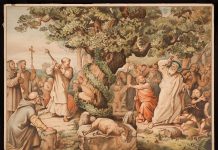The four canonical Gospels are without question the four most important books ever written. These books give us an inerrant portrait of Jesus Christ, God Himself made incarnate. However, they also have come under a great deal of attack, particularly during the course of the last two centuries. In this article, I intend to focus on Mark’s Gospel, demonstrating it to be a book that we can accept as accurate without resorting to blind faith. Indeed, the evidence for its reliability is overwhelming.
First and foremost, in order to establish the historicity of Mark, we must first establish that it was based on trustworthy sources. Who wrote the Gospel of Mark, and where did he get his information?
The early church unanimously agrees that the Gospel of Mark was written by St. Mark, and appear to believe that it was a Greek translation of St. Peter’s Aramaic preaching. They also generally agree that he wrote in Italy, and often specify the city of Rome. Our first and most important witness to this effect is the Church father St. Papias, bishop of Hierapolis, who died in the first half of the second century.[1] Papias’s writings have been lost, but thankfully, a few precious fragments are preserved as quotations in other works. One such quotation of Papias reads:
“The Elder used to say: Mark, in his capacity as Peter’s interpreter, wrote down accurately as many things as he recalled from memory – though not in an ordered form – of the things either said or done by the Lord…. For he made it his one concern not to omit anything he had heard or to falsify anything.”[2]
The ‘elder’ whom Papias is here referring to is most likely John the Elder, a somewhat mysterious figure who had been a disciple of Jesus. It is not clear if this John is the same John as John the evangelist. Papias tells us elsewhere in his works that he obtained information earlier in his life from travelers who had directly heard the teachings of John the Elder while John was still alive.[3] Since John the elder was a disciple of Jesus, he was in a good position to know the origins of the Gospels.
Thus, thanks to Papias, we have early information about the authorship of the Gospel of Mark which is connected to the authoritative testimony of John the elder. He says that Mark worked as the interpreter of what Peter taught. This testimony is later repeated by other early fathers, such as St. Irenaeus of Lyons (writing in France), St. Clement of Alexandria (writing in Egypt), and St. Augustine of Hippo (writing in North Africa). In spite of being spread apart across huge geographical distances that would have made collusion essentially impossible, these men all agreed on the origins of the Gospels, including Mark. This conclusion is further backed up by the fact that all extant manuscripts from the early church of the Gospel of Mark include his name.[4]
Finally, it is highly implausible that the Gospel of Mark would have been falsely attributed to someone like Mark, who was not a disciple of Jesus, rather than a more authoritative figure. If the current titles of the Gospels were chosen purely to lend them authority and not on the basis of historical fact, it seems vastly more plausible that a direct eyewitness of Jesus would have been chosen as the author, rather than a non-eyewitness like Mark.[5]
On the basis of this evidence, we can reasonably conclude that the Gospel of Mark is based on the eyewitness testimony of St. Peter. This gives us reason to trust it as a historical account rooted in fact. But this survey of the external evidence is only half of the story. The content of the Gospel itself gives strong evidence of its historicity.
Richard Bauckham, in his revolutionary book Jesus and the Eyewitnesses, lays out one such line of evidence. Bauckham notes that there was a general trend in Jewish culture to add more names to Biblical stories as time went on.[6] Writers like Philo of Alexandria often retold Old Testament tales, adding in names for previously anonymous characters. Yet strikingly, in the Gospels, this trend is reversed. Most scholars agree that Mark was written first, Matthew and Luke a bit later, and John last. Bauckham writes that although the later Gospels often eliminate names present in Mark, “In no case does a character unnamed in Mark gain a new name in Matthew or Luke… The material common to the three Synoptic Gospels therefore shows an unambiguous tendency towards the elimination of names…”[7] Whenever Matthew and Luke retell stories from Mark, they regularly drop names, and they never add them. Given that this cuts against the grain of typical Jewish practice, it demands explanation.
Bauckham’s brilliant solution is to argue that the names were included in the Gospel of Mark in the first place because they served as the eyewitness sources for the stories in which they appeared. These people would have been well-known in the early Christian community, and anyone who questioned the stories in the Gospels would have been able to verify those stories by interviewing the eyewitnesses who served as the sources of these traditions. The names are eliminated in Matthew and Luke, Bauckham argues, because at that time they would have either died or fallen into obscurity as the Christian community expanded, and as a result, there was no need to name them any longer.
A particularly compelling instance of this phenomenon comes in Mark 15:21, which says “They compelled a passer-by, who was coming in from the country, to carry his cross; it was Simon of Cyrene, the father of Alexander and Rufus.” It seems very strange for Mark to go out of his way to mention the fact that Simon of Cyrene was the father of Alexander and Rufus, since they are totally irrelevant to the story in question. Most likely, Mark only named them because they were known to his audience. Bauckham writes: “The reference to Rufus and Alexander certainly does presuppose that Mark expected many of his readers to know them, in person or by reputation, as almost all commentators have agreed, but this cannot in itself explain why they are named. There does not seem to be a good reason available other than that Mark is appealing to Simon’s eyewitness testimony, known in the early Christian community not from his own firsthand account but through his sons.”[8]
Supporting Bauckham’s argument is the fact that the Gospels reveal a pattern of “onomastic congruence” that would have made fabricating the names in question nearly impossible.[9] Bauckham demonstrates that the most common names in the Gospels were also the most common names in first century Judea. Rare names also show up in the Gospels, however, in a manner that is statistically in accord with larger naming trends at the time. Given that it wasn’t possible to simply “google” the most popular names, it would have been virtually impossible to achieve this highly realistic pattern through legendary development. Bauckham writes: “…It would be very surprising if random accretions of names to this or that tradition would fit the actual pattern of names in the general population.”[10] The only reasonable explanation is that these names actually go back to real people. This is what we would expect to see if Bauckham’s argument is correct.
A second internal argument for the historical reliability of Mark comes from the presence of “undesigned coincidences.” This is an older argument for the reliability of the Gospels, which has recently been resurrected in large part through the work of the scholar Lydia Mcgrew in her book Hidden in Plain View: Undesigned Coincidences in the Gospels and Acts.
Undesigned coincidences occur when two accounts explain each other in a way that seems extremely unlikely to have resulted from fabrication. For example, imagine that you have two accounts of a bank robbery. One eyewitness claims to have seen the robber coming out with untied shoelaces, the other account mentions seeing the robber trip and fall over.[11] The two accounts are mutually confirming, since it makes sense that someone with untied shoelaces would be likely to trip, but it is also unlikely that the accounts resulted from deliberate collusion, since colluders would probably explicitly mention the fact that they are helping to corroborate someone else’s account. Thus, the best explanation is that the two accounts match up because they are telling the truth.
This phenomenon is found throughout the New Testament. Here, I’ll give three examples that are particularly relevant to the Gospel of Mark, all of them taken from Mcgrew’s book.
Firstly, the account of the feeding of the five thousand in Mark lines up in an interesting way with the account found in John. Mcgrew quotes Mark 6:30-31 as saying “The apostles returned to Jesus and told him all that they had done and taught. And he said to them “come away by yourselves to a desolate place and rest a while.” For many were coming and going, and they had no leisure even to eat.” It seems that things were exceptionally busy around the time of the feeding of the five thousand, such that Jesus needed to lead his disciples to “a desolate place.” Mark’s account does nothing to explain this incidental fact. But John’s account gives a compelling explanation. John specifically says that at the time of the feeding of the five thousand, “the Passover, the feast of the Jews, was at hand.” (John 6:4)
Mcgrew writes, “Josephus, (War of the Jews 6.9.3) tells of an estimate of almost three million Jews in Jerusalem for Passover during the reign of Nero… There is no doubt the Jews would have been on the roads in large numbers when the Passover was coming up.”[12] Thus, there is a highly indirect correspondence between John and Mark that confirms both accounts. Mark says that many were coming and going, without mentioning any explanation as to why, while John mentions that the Passover was at hand, without mentioning the fact that this explains why things were so busy at the time. This gives us confirmation of both accounts.
Secondly, let us return to the previously mentioned case of Alexander and Rufus from Mark 15:21. Fascinatingly, Mark’s account here lines up not with another one of the Gospels, but with the letters of St. Paul. Paul writes in Romans 16:13, “Greet Rufus, chosen in the Lord; also his mother, who had been a mother to me as well.” Mcgrew makes a solid case that the Rufus which Paul is referring to here is the same Rufus who Mark references. She writes, “…Paul’s reference to his close connection with Rufus’s mother as being in some sense (presumably metaphoric or spiritual) his own mother indicates that Rufus had gone to Rome from the eastern side of the Mediterranean (where Jerusalem was), since Paul had never been in Rome at the time that he wrote this epistle.”[13] This would make sense if Rufus was the son of Simon of Cyrene, who was present in Jerusalem at the time of the crucifixion. Furthermore, Mcgrew points out that the overwhelming patristic evidence supports the claim that the Gospel of Mark is based on the preaching of Peter in the city of Rome, which fits in well with St. Paul’s mention of Alexander and Rufus (who, as mentioned previously, show up only in Mark) in his letter to the Romans.
It is still possible that there are two men named Rufus, but nonetheless, it seems quite probable that Paul and Mark are referring to the same person. This further strengthens Bauckham’s argument about Rufus and Alexander being known to the original audience of Mark. It would have been possible for the audience of Mark’s Gospel to question Rufus, and if his testimony did not line up with the account of the crucifixion given in Mark, Mark’s account would have been falsified. This provides confirmation for Mark’s story about Simon of Cyrene helping Jesus carry His cross.
A final example of this phenomenon concerns the trial of Jesus. Mark 14:57-58 says “And some stood up and bore false witness against Him [Jesus], saying “we heard Him say ‘I will destroy this temple that is made with hands, and in three days I will build another, not made with hands.’” It seems that Jesus is inaccurately quoted here, but none of the Synoptic Gospels contain His original words. Yet John 2:19 does contain the original quotation of Jesus, wherein He says, “Destroy this temple, and in three days I will raise it up.”
Mcgrew’s commentary is worth quoting at some length:
I must stress here that John nowhere includes in his Gospel the story of the witnesses who said that Jesus threatened to destroy the Temple… It is only by putting the two together that one gets the whole story: Jesus makes a cryptic statement about His own ability to raise up the Temple in three days if it is destroyed. He intends it as a prophecy of His resurrection, though He doubtless knows that it will be confusing and annoying to His interlocutors. It is remembered against Him, garbled somewhat in the retelling, and brought back up at His trial later as an accusation that He was making the equivalent of terrorist threats against the Temple. This picture is realistic and believable, but it comes to us only by way of the combination of John and the account in Mark/Matthew. Nothing could be less like design or more like truthful testimony.[14]
Even more examples could be given, but these three are a sufficient introduction to the role of undesigned coincidences in Mark. Mark’s account doesn’t remotely resemble a fictional narrative – instead, it connects in improbable ways with the rest of the New Testament. These connections provide strong evidence that Mark’s Gospel is rooted in history.
In conclusion, then, we have seen that the Gospel of Mark is based directly on the eyewitness testimony of St. Peter, as evidenced by the Church fathers and by early manuscripts. Furthermore, we have seen that this eyewitness testimony is supplemented by various other named eyewitnesses, such as Rufus and Alexander in Mark 15:21, who were placed within the narrative in order to verify the accuracy of the story. This is further confirmed by the statistically realistic pattern of names within the Gospel of Mark. Finally, we have seen that the Gospel contains “undesigned coincidences” that serve to support various specific details within the text.
The evidence speaks for itself. Mark’s Gospel is not the end product of a long process of legendary development, nor is it a bungling, incompetent biography of Jesus. On the contrary, it is based closely on eyewitness accounts, and paints a compelling, historically accurate portrait of Jesus of Nazareth, true God and true man.
Endnotes:
[1] The exact date of his death is disputed. Richard Bauckham argues that Papas wrote sometime shortly after 100 AD. Other scholars disagree, however, placing the writings of Papias around 130 AD.
[2] Eusebius, Hist. Eccl. 3.39.14-16, as quoted in Jesus and the Eyewitnesses (1st ed.), Richard Bauckham, 203
[3] For a discussion of the relevant passages, see chapter two of Jesus and the Eyewitnesses.
[4] Brant Pitre, The Case for Jesus: The Biblical and Historical Evidence for Christ, 15-17
[5] Pitre, 22-23
[6] Bauckham, Jesus and the Eyewitnesses, 44
[7] Bauckham, 42
[8] Ibid., 52
[9] For an extended discussion of this phenomenon, see chapter 4 of Jesus and the Eyewitnesses.
[10] Bauckham, 74
[11] I am grateful to the apologist Erik Manning for developing this illustration.
[12] Lydia Mcgrew, Hidden in Plain View, 64
[13] Mcgrew, 122
[14] Mcgrew, 72-73











